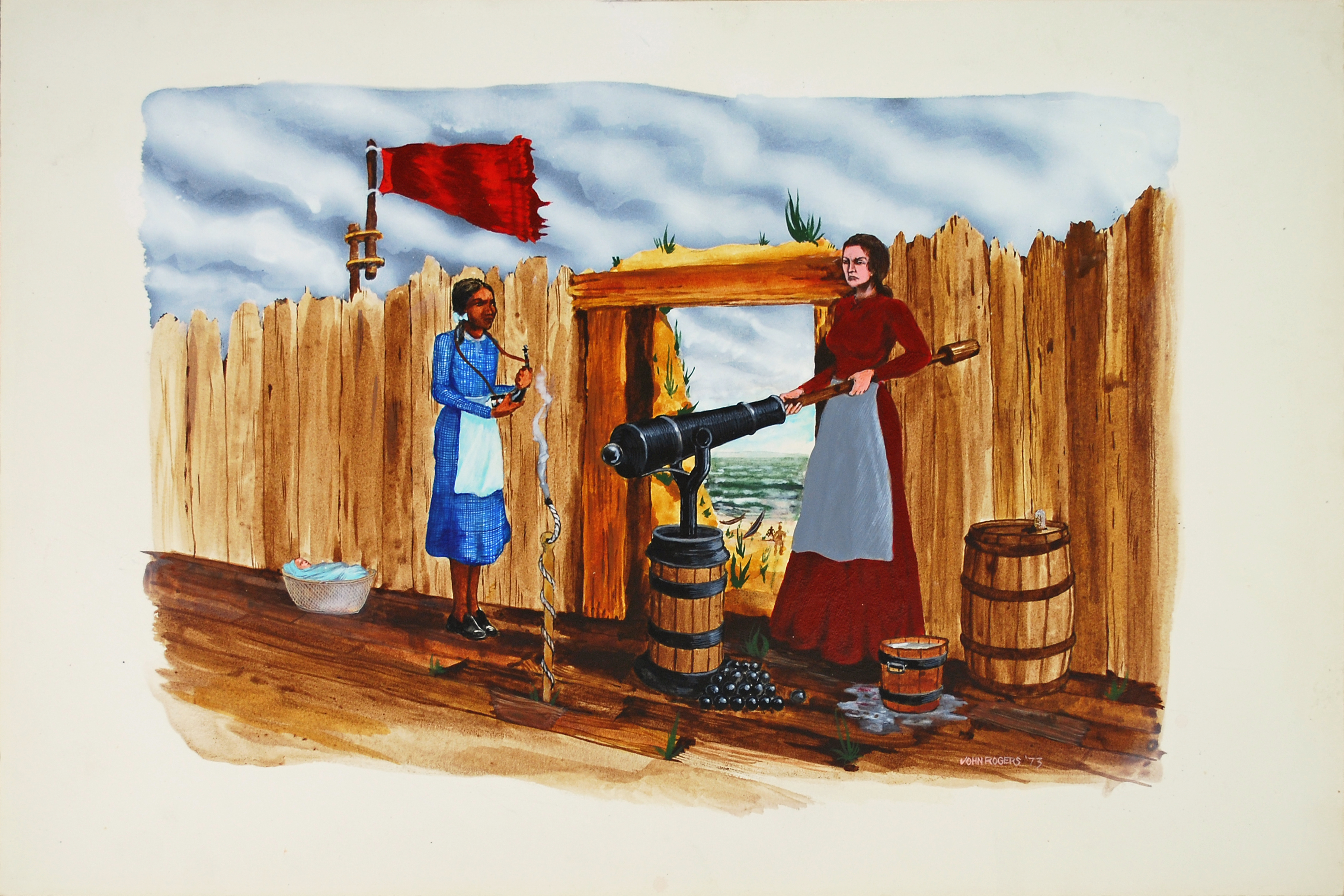This painting is a watercolor entitled “Kiamta Long and Jane Long” by artist John Rogers. The painting references the life of Jane Long (1798- 1880) and her time at Fort Las Casas on Bolivar Peninsula with Kiamta Long, her slave. The painting shows Jane Long loading the fort’s cannon, which she used to trick a group of Karankawa Indians, who greatly out-numbered her on the bay of at the fort. Cannon balls, water, a barrel of gunpowder, and a lighting stick are also featured in the painting which Jane would have used to prepare the cannon. Kiamta also referred to as Kian or Ki, stands near Jane holding the signal horn given to Jane by the famous pirate Jean Lafitte. In the background of the painting stands the fort’s wooden walls and the opening reveals the gulf behind the fort. The painting also features Jane’s red flannel petticoat she used to represent a presence of many people at the fort to the Indians. The painting also features baby Mary James Long who was born at the fort.
Jane Long was born Jane Herbert Wilkinson in Charles County, Maryland on her family’s land called “the Heights” on July 23, 1798. Jane was the 10th child born to Captain William Mackall Wilkinson and Anne Herbert Dent Wilkinson. When Jane was only one year old her father died leaving her mother, a widow with many children. Jane’s mother then moved the family to Mississippi to be closer to her relatives. Shortly after the move Janes’ mother also died, leaving Jane and her siblings as orphans. Luckily for Jane, one of her elder sister’s, Barbara Wilkinson Calvit, was able to take her in. Jane’s sister lived in Washington, Mississippi near Natchez. It was in Natchez, that Jane met Dr. James Long returning from the Battle of New Orleans, the last major battle of the War of 1812.
Quickly, James and Jane fell in love and married on May 14, 1815 and she became Mrs. Jane Long. The newly married couple moved to a plantation at Walnut Hills, Mississippi where Jane gave birth to their first daughter Ann Herbert Long. While living in Walnut Hills, James became a merchant, opened a store and stopped practicing medicine. In 1819 the couple again moved back to Natchez, a great trading center at the time where James could expand his business. During the same year, residents of Natchez were outraged by the Adams-Onis Treaty of 1819 which relinquishing the United States claims on Texas, in exchange for Spain ceding Florida to the US. James Long joined the cause and soon became leader of this group of outraged citizens. The citizens appointed James Long the commander of an expedition to free Texas from Spain. As part of this expedition, James Long was able to capture Nacogdoches, where he declared Texas a free nation, with himself as President. Needing supplies and support for his expedition, Long sought out the French pirate, Jean Lafitte, near Galveston. Jane eventually followed her husband to the settlement he founded along Galveston Bay, Fort Las Casas.
The cause of Texas’ Independence soon called Long again from his wife to San Antonio then, Mexico City where he was killed. While waiting for news of Long’s death, Jane continued to stay at the fort as her husband’s men, and many of the other settlers abandoned the fort. Determined her husband would return for her, a pregnant Jane stayed with Kiamta, and her daughter Ann. Winter bought a terrible blizzard, which the women survived by living in a tent eating corn meal, salted fish and oysters they caught. In addition to the hardships of weather and lack of food, the women were also routinely threatened by the nearby Karankawa tribe of Native Americans. In order to maintain the illusion of a well manned fort, the women would dress as soldiers and use their petticoats as flags. On at least one occasion, the women were forced to use the fort’s cannon to scare off the potential attackers.
Eventually, Jane and her family left the fort with a family who happened to be passing by. Years later Jane moved back to Texas with her married daughter, opening her house as a boarding house. Jane’s boarding house included such famous guests as Stephen F. Austin, Ben Milam, William Travis, Sam Houston and Mirabeau Lamar, many of whom also were legendary suitors of Mrs. Jane Long. After many years, Jane eventually closed her boarding house and moved in with her grandchildren who cared for her until her death on December 30, 1880.
